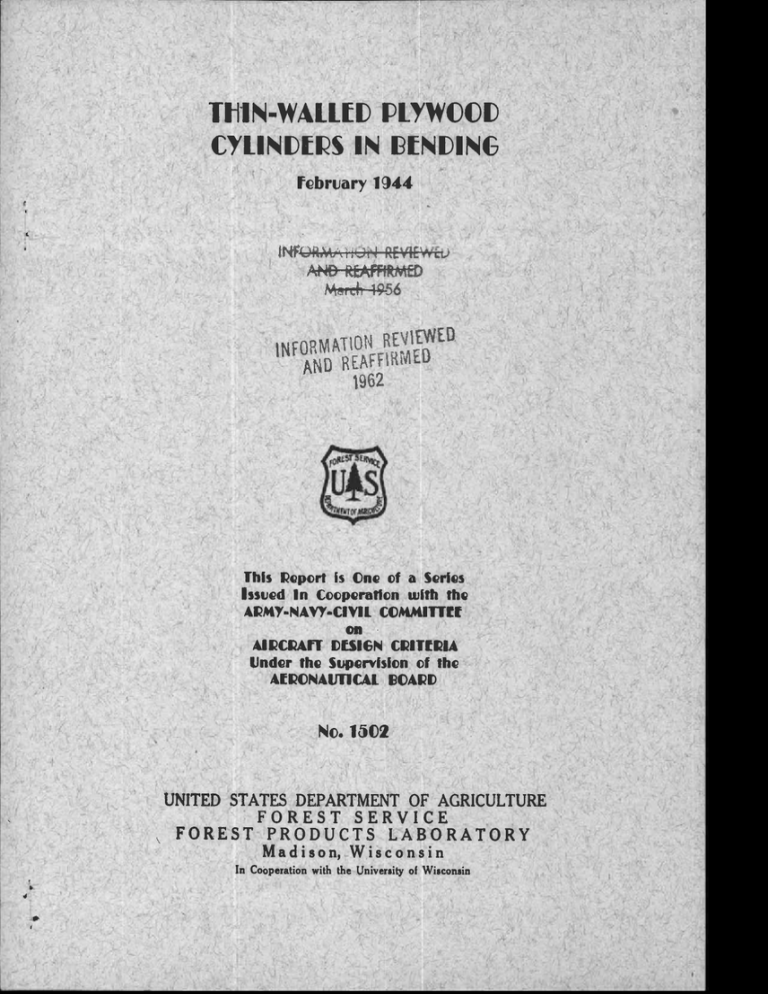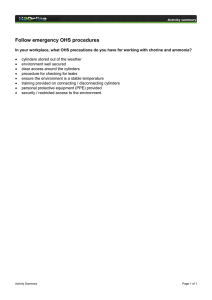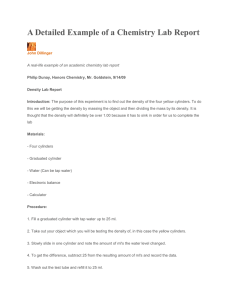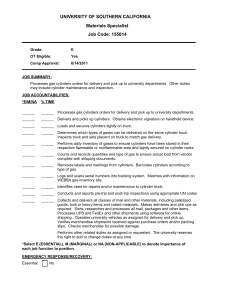WIN-WALLED PLYWOOD CYLINDERS IN LENDING INFORMATION REVIEWED AND REAFFIRMED
advertisement

WIN-WALLED PLYWOOD
CYLINDERS IN LENDING
February 1944
INC4414MA*=11.4-RPAEleott)
ArNek-littAFFIRMED
Wcyrc+r-49-56
INFORMATION REVIEWED
AND REAFFIRMED
1962
This Report is One of a Series
Issued In Cooperation with the
ARMY-NAVY-CIVIL COMMITTItt
on
AIRCRAFT DESIGN CRITERIA
Under the Supervision of the
ALIPONAUTICAl. BOARD
No. 1502
UNITED STATES DEPARTMENT OF AGRICULTURE
FOREST SERVICE
FOREST PRODUCTS LABORATORY
Madison, Wisconsin
In Cooperation with the University of Wisconsin
THIN-WALLED PLYWOOD CYLINDERS IN BEV:DIP:A
By
EDWARD W. KUENZI, Assistant Engineer
Summar y
This report presents the results of tests of thin-walled plywood
cylinders in bending. All specimens were simply supported at the ends and
loaded at the third points. It was found that the results of bending tests,
when plotted, developed a curve similar to that representing the results of
compression tests reported in Forest Products Laboratory Mimeo. No. 1322,
0 Buckling of Long, Thin Plywood Cylinders in Axial Compression." The tests
...1 cylinders in bending indicated buckling stresses about 10 percent higher
than for the same cylinders in compression.
Descrip tion of Specimens
Specimens were mede of aircraft grade yellow birch veneers, rotary
cut at the Forest Products Laboratory. Three types of plywood were used:
three-ply with faces of 0.010-inch and core of 0.025-inch veneer; five-ply
with faces of 0.010-inch, cross bands of 0.025-inch, and core of 0.0125inch veneer; and five-ply with faces of 0.010-inch and cross bands and core
of 0.0167-inch veneers. Nine cylinders, each 10-1/2 inches in diameter
and 46 . inches long, and three flat panels for minor coupons were made of each
type of plywood; three with the face grain in the axial direction, three with
the face grain in the circumferential direction, and three with the face grain
direction at 45° to the axis of the cylinder. In all instances the grain if
adjacent plies was at right angles.
All plywood was manufactured flat with a film glue set in a hot press.
Ile cylinders were formed by bending the flat p lywood around a mandrel. Prior
ts, , forming, the plywood was scarfed, then moistened to facilitate bending,
and finally bent around the mandrel upon which the scarf joint was glued with
a thermosetting synthetic resin glue. Snugly fitting plywood diaphragms,
3/4 inch thick, were glued in the cylinders at the reaction and load points
fig. 1). The cylinders were proportioned so that under third-point loading
•This mimeograph is one of a series of progress reports prepared by the Forest
Products Laboratory to further the Nation t s war effort. Results here reporter
are preliminary and may be revised as additional data become available.
Restricted_ Mimeo. 1502
-1-
the diaphragms at the load points were about 1-1/2 diameters apart.
No attempt was made to condition the specimens to a particular
moisture content other than to keep them in the testing laboratory for about
a week before testing.
Testing Methods
Each cylinder was tested in a hydraulic testing machine which was
fitted to load the specimen by means of thin steel straps passed around it
at the load diaphragms. The specimen was placed so that the scarf joint was
on the tension side. The ends of cylinders that did not fail in the shear
portion of the cylinder beam during the'bending test were subsequently cut
and tested in compression. .
Several metalectric strain gages were placed at midlength of one
specimen. TA-le readings of these gages showed the strain distribution on a
cross section of the cylinder to be approximately linear.
Minor specimens were tested in bending, compression, and tension to
determine the mechanical prop erties of the material. The testing procedures
followed for these coupons are described in Forest Products Laboratory
Mimeo. No. 1322-B (supplement to No. 1322).
t Results
Test
Most of the specimens subjected to bending failed by buckling
suddenly, with the plywood breaking immediately afterward. As soon as
buckling occurred, the load dropped to less than one-half the buckling load.
In size and shape, the buckles were a pproximately the same.as those found
in previous compression tests.
Many of the specimens buckled in the shear portion of the beam.
About 90 percent of those with axial face-grain direction, and 50 percent
of those with the face-grain direction at 45° to the axis, failed in that
manner, but none of the specimens with circumferential face grain failed
in any portion of the beam other than the middle third.
Computation of Results
The bending stresses (table 1) at maximum load were computed from
the formula
M (r +
2
fb =
3
ITX t
Restricted. Mimeo. 1502
-
where
fb = stress in most remote fiber in pounds per square inch.
M = maximum bending moment in inch-pounds.
r = mean radius of the plywood cylinder in inches.
t = thickness of plywood in inches.
The buckling constant (k) was computed by means of the formula
k
fb r
E t
where EL is the modulus of elasticity of the birch veneer. The values of EL
were obtained from teats on minor coupons and were computed in the manner
discussed in Forest Products Laboratory Mimeo. No, 1322-3.
The buckling constant (k) for the compression tests was computed
from the formula
k
Eh
where p is the average compressive buckling stress of the cylinder and h is
the thickness of the plywood.
Figure 2 shows the results of the tests in bending and compression and,
for comparison, the theoretical buckling curve for plywood cylinders in
compression as taken from Mimeo. No. 1322.
The buckling coefficients for cylinders with 45° face grain were
obtained from the coefficients of identical cylinders with 0° and 90° face
grain and, therefore, were not readily plotted in figure 2. In figure 3
the buckling coefficients for all of the cylinders tested in bending were
plotted against the coefficients for the matched cylinders tested in compression, including those with the grain at 45° to the axis.
The strain distribution in bending at a cross section of one cylinder
is plotted in figure 4. The data given in this figure include values for
effective modulus of elasticity (E a) in compression or tension. Those values
were determined from the tests on the minor coupons.
Distaid4ift of Results
The curves of figure 2 show agreement as to form between the theoretical curve for thin-walled p lywood cylinders in compression and the
actual curves obtained for both bending and compression. The curve
representing the compression tests, however, seems low. The cylinders
Restricted Mimeo. 1502
-3-
tested in compression were aut from the ends of the cylinders previously
tested in bending and may have been slightly damaged in this previous test;
moreover, the data of Mimeo. No. 1322 indicate that much scatter of the
points can be expected,
The curve for the buckling constant for bending tests lies well above
the theoretical curve for plywood cylinders in compression Ove;.., the range
El
in
commonly used in design. Considering only the curves that were
2 1 E2
obtained from the present tests, it is evident that the increase in bending
stress over compression stress when buckling occurs is about 25 percent
E l
values
values are small, and about 10 percent when when 7 4El + 22
"j 1
22
approach unity. The difference in percentage increase may be due to the
fact that cylinders with axial face-grain direction are not as round and
are likely to have greater ' initial imperfections than cylinders with
cirumferential face-grain direction.
These tests were conducted on specimens that were free to buckle in
a length equal to about 1-1/2 times the diameter of the.cylinder. A length
effect will no doubt be obtained if shorter lengths are tested; cylinders
of shorter lengths will have higher.buckling stresses. Due to differences
in the aspect ratio of the buckle size, this effect will be greatest in the
specimens having axial face grain and. least in those having circumferential
face grain.
The points plotted in figure 3 show that in most instances the
-bucklingstrengthsinbedingarehigerthanthoseincompresion.Ther
is a great deal of scatter, but from past experience this is to be expected
for thin-walled cylinders of any material.
The strain-distribution curve of figure 4. shows that an approximately
linear relation exists between the strain and the distance from the neutral
axis, and that the neutral axis lies nearly at the center of the section.
Deviations from these conditions may be attributed to variations of the
effective modulus of elasticity of the material and to some shear stresses
in the central portion of the cylinder. The ordinary flexure theory applies
with reasonable accuracy to the buckling of thin-walled plywood cylinders,
provided the compressive stress at the elastic limit of the material has
not been exceeded.
Conclusions
The buckling stresses of thin-walled plywood cylinders in bending
can be computed by the ordinary flexure theory provided the elastic limit
of the material is not exceeded.
The buckling stress of a thin -walled plywood cylinder in bending cam
be assumed to be about' 10 percent higher than the computed buckling stress
of the cylinder in compression.
Restricted Mimeo. 1502
-4-
•
•
C
•
u s. .+.+..
gg
01: US:
P
ol g o
C NNW WP P VII
;4PPP
ggo
gl
C24)COO CAC OCC
NAM NMA AAA AAN ANN XXX AAA
C
5
C
0
124. ,
gC5 2
r -St
0 C3 0. 0. 00
. . .
a
C
SVS
r
gC614
.SZA
H
MN 0.4 0
. . H.
,r1
m.
1.4 0-1
. .
.
.
. .
O
EO
Mg makel LAU10% WMN 1.-34 OMM MO/4 UNA.1 4.400
O
SE2
°
jg
=2
=Ts %II. P=1'
C
••
O
•
•
C
0a
F,I4 ni gg4 .n g ,pONO
2.22 pg
i 82
g 'in
wONT.-
MO, 0,m m
NO
n %.c - M N. Ww 0,..40
] ,I,l H4,; rrt,1 OC:0.
..A .,.c. 44c. .44 A44
4-1
M
0
~
2,?4 ggg "' 00 000 ”r2
g2 223
8R
4• .). 7 0..03
'1M„
'0,4.
NMO ,0,0. ,or-ir, t g r. -g-mm 20,0,
. ..„ ....Z4o
i mm NA7e:
•4A 4,4. 4,A4 AAA 4.; ;4A
ca
prAn
.P^0^0^.
4-Ar
0 mM mm, -,m
8 .7.7 N N N NNN WAIN
•
.
UN
--
C
01 •
•
eav
M q c
Ud
V OA
•
M cogo
com
gt
PAMPA
88 888
vow
6 mmm
Err`
•
MMM
Cr.v3,
WNN
umiNUN
MMM Ws.0%0
‘0,0,0 mmm
f-4,4,-
101010
NNN
bre
......... ......
...... LnOlLil
...... LillAtf,
... r--r-1.--
.....• M1-1--4,-
.. WWILAN
....... 1-...P-A--.
.. t. N.
A O-W• LfuniON iturw, MNal NNW Nmw uo50 ..0 ‘05050 ..0,..0..0 e
o mai NCLIN
.-1,1p-1 r1 .4.i
WNW 1-lei.-1 i4i-1.4 4-1,1,1 n-1,-1
N
000 000 Opp oloo 000 000 000 000
..
H 00
•
.• ... ... ... ... ... ...
^^•
A
Tumn
NNN
['JAIN
Nall mHM
000 000
121
—
•
0
--
- - -
A
LIW)WN
cunAN
mmm
N.-IN 000
MMM 000
MHM
•
•
000 000
O
- - - - - - - - - - - - - C
.0
11
4.
•
M
A
2 §§§
000
000
3 § 9
. • • 222
.__• • 222
• • • §§§
• • • §§§
• • • PA§
• • • §§§
• • • §§§
•••
. 0
oul
O
S.
• 00 009 irunifl 000
CAW.W, Ostst
MM MMM MMM
000 ifunirs 000 000 UNIVA
CrsCP,O,
CACAO, 333
~sr,
itursu,
,rmn
ffvfmn irfintrl
N
•
1A
0
k
0
MAIM HNM HAIM
.mm .mm
0
F.
0
:
•
0
0
•
n
00
C
MN MAM MAIM MAIM
0
44
00
C
.4
.r1
J4
0
.0
0
2
2
•U 4AA AAA 444, LUA 444 ri g41 444 (WA
‘0
M
Ls,
W
LOAD OM PHRA45
PLYWOOD CYLINDER
END D/APHRAGM
7igure l.--Apparatus for testing thin-walled plywood cylinders in
bending.
M 51682 7
en
co
•
a
r-f
O's
0
•
o
Reg
•
ur
Itt
4.1
2
in
tk.J
CZ
e)
§
E
6L.1
tr)
4.•
fk;
co
tka
'rj •
4•1
0
co
144
4
2
J
/14
kr1
Lki
"z{
qa•
g
oo
LQ
4D 0
DI vi
0
o
k
o
-la
0 0
it
O
O
1.'
o
a
N
...
cs
0
co
n4:,
cs
cs
cs
cz)
N1N7/9/.1.i g02 9N/7 N.911g
cz,
0.16
eA
0 t4
til‘
ti / t".
45 / ?
av 0
62
0 2
bti —6
0.14
5/0
'ip
6, (IV
E63
B/
230 c'
tk1
022
1,,t,./.4( tcst,
no 052
93
1) d9 07`
E-192 g ' \c"
AN,'
/043
IV
33 •/
k
4/
.3 010
053
OW
'•I I
/
Lk1
•
.32
L.)
D0.08
/
/
/
cl 006
c
/
LEGEND:
0-0° OR* 90° CYLINDERS
n —45° CYLINDERS
• OR n —CYLINDERS WH/CH BUCKLED /N
THE END .SECT/ONS OF THE BEAM
/
0.04
0.04
1
006
!
0./4
0.12
0.16
0.10
0.08
BUCKLING COEFFICIENT (COMPRESS/ON)
llgure 3.—A comparison of the buckling constant of thin-walled plywood
cylinders in bending with that in compression.
2 M 51084 F
0.18
,. 1
k
k
c<
'1.1
4.4
ct.
4.4 R
ir,
cF
Izi
..3
v
LL4
..--
k
c:s ci,
-
..., .,
R
ctc:,4,z)
,
L44
,
Z
IQ
—
R
cc
.t
•::1
Zt
in
0
ei 's
I,
k
*1' 1."' CK
r
ao
irn
Ag&A„
AXX:X.X..-
4
411 IT
,
A
ir
At
r
AA
r
przr
or
.ddrA r
(z; T( ca cs
q a
----cz' . (=5'
z r r
L''
kl..]
A.
1:
+7:. k
cs
I'S 144
411 'cil..
L'-‘
trl
*
1
N 1-;i
•
AP
111
-- 41 (_
,,
VI
%1111 k
•„
,z1,
LcxL
W
Z{::.
.- -
tz;
'z!
C)
v
1.c
ss iron
,...,
,
,:::,
g
k- 3 c`? C.)
'r,..
h
I'?
kt) VI 0 N Li
r"-+Li-, k
,...; n 44
1
,,,-••
A VA
1/43
-11
v1 ....z
,
'°
tzl u
k lz,
-...
4.,.
s: k ° tk
--.. kJ
0,
11
Aril
l'ear
1
-or
,`-f1
arAug 4,1
r
4.
r
z
z
Ar
41 lb
-.1
vt %kJ i--.
e< t `•5 ,4
%,..i zt ec n,,
Pt:4 r-.,I'l
. -"- u
k a .....
i.,, a ,
•
1.44.1qz3a
IZI
• v,'
,,,
„,,,,
1,..)
t6
czi tS Cti
CI 5..7,i
.."`
-
• :
ir AV r
AA
. _4,
.,,
1. i.... :-..
,i,„
N
I 6.. 1 o , cz
" iej
4). k '-), 13'c' " 4,j k3 1...„ ck
w..! N[ lizi -c ek
L , k „ •Tc
,
k., II
— cz.
k v,• izs
i•r) CY >
---.
- • - tr)' •• 10-$ ''';C n
...
,iv,,,r.
V
Ard/r
1ZdirA4
N 4. 4
,4
1
F.,
1I . Z
n
0
In.
,
k
o
n
, tZ7 a,
kr,
--4.
ec
144
tk.
‘,-)
III•
C2'
V)



